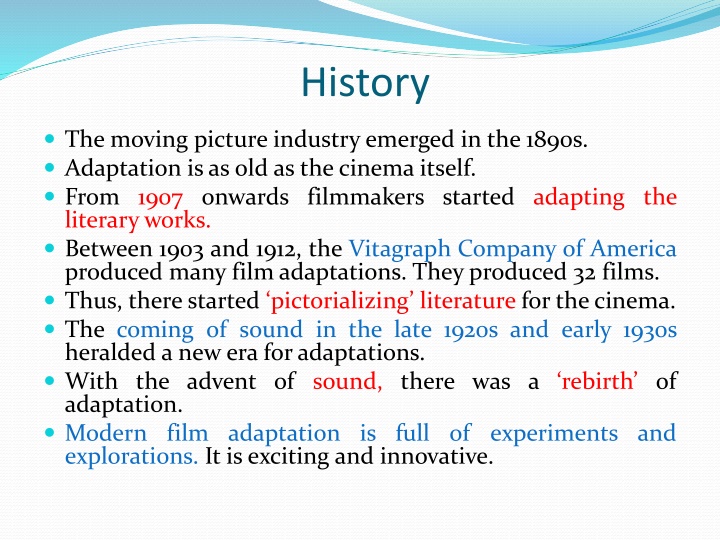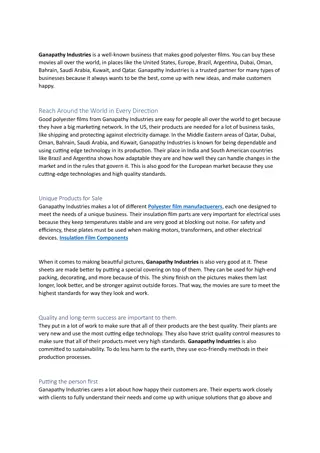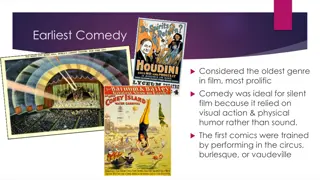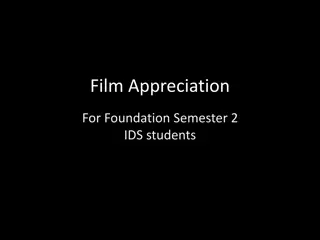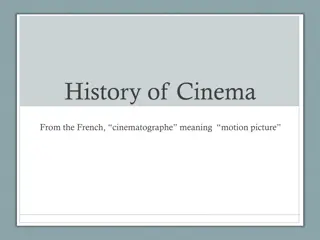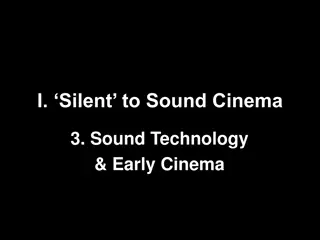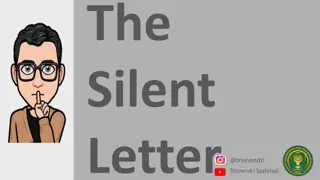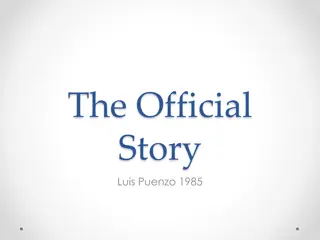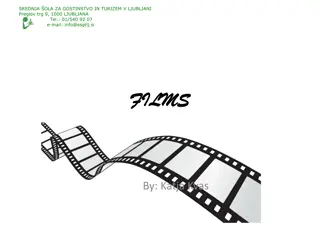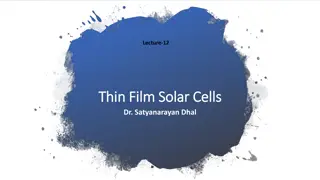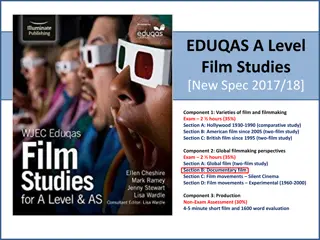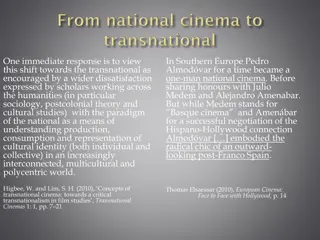Evolution of Film Adaptations: From Silent Cinema to Modern Innovations
The moving picture industry emerged in the 1890s, paving the way for adaptations of literary works in the early 1900s. With the advent of sound, a new era of adaptations began, leading to experiments and innovations in modern filmmaking. Adaptation is a process of adjusting and presenting a work in a new form, influencing how films interpret novels or plays. Filmmakers often make creative changes to adapt works, creating autonomous pieces of art guided by contextual factors.
Download Presentation

Please find below an Image/Link to download the presentation.
The content on the website is provided AS IS for your information and personal use only. It may not be sold, licensed, or shared on other websites without obtaining consent from the author.If you encounter any issues during the download, it is possible that the publisher has removed the file from their server.
You are allowed to download the files provided on this website for personal or commercial use, subject to the condition that they are used lawfully. All files are the property of their respective owners.
The content on the website is provided AS IS for your information and personal use only. It may not be sold, licensed, or shared on other websites without obtaining consent from the author.
E N D
Presentation Transcript
History The moving picture industryemerged in the 1890s. Adaptation isas old as the cinema itself. From 1907 onwards filmmakers started adapting the literaryworks. Between 1903 and 1912, the Vitagraph Company of America produced many film adaptations. They produced 32 films. Thus, there started pictorializing literature for thecinema. The coming of sound in the late 1920s and early 1930s heralded a new era foradaptations. With the advent of sound, there was a rebirth of adaptation. Modern film adaptation is full of experiments and explorations. It is exciting and innovative.
Adaptation and Filmmaking: Adaptation has always been central to the process of filmmaking since almost the beginning. Making a film of a book requires the production of a version of it. So there is always something a bit restrictive, a bit secondhand about adaptation. Both in Hollywood and Bollywood film industries, many novels, plays, biographies, histories and other published stories have been regularly filmed, sometimes with good results. The novels of Henry Fielding, Thackeray, and Thomas Hardy have been filmed both by Hollywood and Bollywood.
Adaptation : Meaning Theword adaptation finds its origin in Latin Word adaptare : fit in In the process of adaptation something is adapted, changed and presented in another form According to Linda Hutcheon, to adapt a work means to adjust, to alter, to make suitable The adapted thing is, thus, modified in order to suit new conditions. In the process of adaptation, the structure and function of an entity is altered in orderto suit to the newenvironment. In the context of media, adaptation is defined as a movie, television drama, or stage play that has been adapted from a written work, typically a novel ora play.
What does a film owe the novel or play on which it is based? How does a film remain faithful to its source? (Has it preserved major characters, theme/s, and plot/s?) Is a film a version of a story or an autonomous work of art? Which text is given primacy: the novel or the film? Why do motion picture producers make so many changes in filming a novel?
Thats not in the Book Why? Adaptations are guided by situations, circumstances, time, era, culture. Film adaptation a kind of paraphrase Adaptation is a process of creation and reception. Filmmaker becomes the author of a new work. Films are completely autonomous works or arts. Films often distort characters, twist plots, change endings. Essential element in a literary text is word ; while the essence of movie is movement and action supported by sound . Filmmakers eliminate descriptions, conflate or dismiss minor episodes and characters and minimize dialogue. They have to think only of action suitable for picturization
Thats not in the Book Why? Screen narratives move at faster pace than most novels, hence any detail extraneous to the plot has to be omitted. Hence there is : condensation, incorporation and modification Condensation : choosing or discarding plot elements Incorporation: adding scenes to fill in any gaps in the narrative Modification: To help bring the moral tone of the narrative into conformance with Production Code standard. The Adapter must control the script s length.
Thats not in the Book Why? Adapter has to locate chief characters and central theme and then transform those into a film that delivers a story of sittable duration Roy Paul Madsen, in his book The Impact of Film (1973), writes: Only superficial similarities exist between films and novels because the two are as different as music and sculpture . An adapter has to formulate the same story in a different landscape, culture, setting, time-period or even background. For example, Shyam Benegal s Kalyug (1981) is a modern day adaptation of the century-old Indian Epic Mahabharata. In it, the screenplay and plot are quite different but the characterization and critical events have a striking similarity with the epic.
Thats not in the Book Why? Cultural diversity, social milieu, economic limitations and perceptions of audience play an important role in adaptations. ( Haidar, Omkara, Natsamrat ..) Often filmmaking requires reorganization of the material, a different construction. Film adaptation is not just the change in the time period, but also the addition of scenes, voices, sound, music, props, etc. It is the director s choice : he may adapt a work as faithful as he can or may extract the essence of the text and develop it in a new setting.
FIDELITY Has the filmmaker adhered to correct meaning or in some sense violated or tampered with it? Is it faithful to the letter and the spirit or essence of the work? The problem with fidelity approach is that it gives primary importance to the novel/play and treats the film as if it were an inferior work. A successful and faithful adaptation captures the spirit of the book. It does not miss the message of the novel/play .
FIDELITY Is the film wholly appropriate to the author s intentions? Success and fidelity have nothing to do with each other. Pride and Prejudice is successful not because it is faithful to the text, but because it does something to the text. The Great Gatsby is unsuccessful because the film does not do anything with the text. On the screen it reads like a book. In it the question of Interpretation is minimized. Hence unsuccessful. Great adaptations bring novels to visual and dramatic life. By taking liberties with character and structure, film adaptations cast new light on the original.
ADAPTATIONS AS INTERPRETATIONS In best adaptations , filmmakers highlight certain aspects of the text and raise new questions. Thus, they put the novel into a new form. This allows the reader/viewer to see the novel from a new perspective. The filmmaker uses the film as an interpretative device and opens up the text to new possibilities. The art of adapting literature is interpretation more than reproduction(Neil Synyard Filming literature,1986) A translation is itself an interpretation.
Transpositioning Transposition, in Adaptation Studies, refers to the formulation of the same story in a different landscape, culture , setting, time-period or even background. For example, Shyam Benegal s Kalyug (1981) is a modern day adaptation of the century-old Indian Epic Mahabharta. In it the screenplay and plot are quite different but the characterization and critical events have a striking similarity with the epic.
Transformation Transformation is that adaptation that employs all the movie-making conventions in cinema at the same time remaining faithful to the original text. Kishore Sahu s Hamlet(1954), an adaptation of Shakespearean text, retains most of the original in dialogue, dress and location at the same time utilizing movies-making conventions (songs, etc.) of Indian cinema.
Transcoding and Appropriations Transcoding is linguistic. It is the conversion of meaning in one language into a similar meaning in another language. It provides more cultural flexibility to an adapter. Appropriation is more interpretative or explanatory in scope. We call it Appropriation because the screenwriter adapts the story for specific use. Appropriation simply seeks the moral or the crux of the text and presents it in a new form.
A Theory of Adaptation by Linda Hutcheon To adapt a work means to adjust, to alter, to make suitable . Transposition: the change of medium or the change of context Creation (Appropriation and Salvaging): saving an old text from being forgotten, or paying homage to a previous text Reception (Appreciation): taking possession of another s story An adaptation is a derivation not derivative a work that is second without being secondary. With a change in form there occurs a considerable change in both the depiction of story and its receiving.
Theory of the Film by Bela Balazs The film script is an entirely new literary form. It is an independent work. The novel is a potential raw material. It is transformed at the will by the writer of the screenplay. The screenplay writer, thus, creates a new artistic version by incorporating a new aesthetic design and technology. Even though an adaptation takes the subject of another work, it is an entirely new entity. As literature provides the raw material for film adaptation, there are several variations possible. Balazs abandons the notion of equivalence. He gives the filmmaker the complete license to extract what is useful and abandon what is not for the cinematic medium. This new work is neither less worthy nor inferior to its source work. Adaptations are distinctive works of art.
Andre Bazin The novel and the drama are not raw material to take from and render visually. Faithfulness to a literary source, its spirit is fundamental nature of adaptation. The adapter must keep in mind the vision of the creator and the spirit of the work. Adaptation is a form of translation from one language to another. The filmmaker should be a fine craftsman and should have powers of invention to create a new structure different from but parallel to the original. The novel is a stimulus and the adapter is an interpreter. Film adaptation is neither a replication nor a substitution, but it is re-experience in another medium.
Novels into Film (1957) by George Bluestone An adaptation is a type of raw material that paraphrases thematic content. Characters, key incidents and thematic high points become reproductive qualities for the film. In the process, the adapter becomes the true author, not a mere translator of another s work. He calls the adaptation a new work of art and the adapter a creator. He also believes that the film adaptation becomes a different artistic entity. Thus, he thinks in the line of Balazs. He suggests that the adaptation is not simply a stage between two media. The novel and film meet at a point and then diverge.
Ten secrets to become a successful adapter by Andrew Davies 1. Read the book. 2. Ask yourself: Why this book, and why now? 3. Ask yourself: Whose story is this, really? 4. Don t be afraid to change things, especially openings. 5. Don t start without a plan. 6. Never use a line of dialogue if you can achieve the effect with a look. 7. Crystallize dialogue to its essence. 8. Write scenes that aren t in the book. 9. Avoid voice-over, flashbacks, and characters talking directly to camera. 10. Break your own rules when it feels like the right thing to do.
Theory of Film by Seigfried Kracauer Kracauer makes the distinction between cinematic and uncinematic . To Kracauer, adaptations make sense only when the content of the novel is firmly rooted in objective reality, not on mental and spiritual experience. According to him, if an adaptation fails, the fault lies not in the film but in their sources, which are either cinematic or uncinematic . He says that realistic and naturalistic novels are most suitable for adaptations.
Thomas Leitch: Adaptation --a subset of intertexuality 1. Adaptations are exclusively cinematic. 2. Adaptations are exclusively intermedial, involving the transfer of narrative elements from one medium to another. 3. Adaptations are counter-phrases. 4. Adaptations are texts whose status depends on the audience s acceptance of a deliberate invitation to read them as adaptations. 5. Adaptations are examples of a distinctive mode of transtexuality. 6. Adaptations are translations. 7. Adaptations are performances. 8. Adaptations are quintessential examples of intertexual practice. 9. Adaptations are a distinctive instance of intertexuality.
The Novel and the Cinema (1975) by Geoffery Wagner Transposition : A novel is directly given to the screen with minimum interference. Wagner calls this method most pervasive and least satisfactory. For example, Robert Stevenson s film Jane Eyre (1944), William Wyler s Wuthering Heights (1939) and Vincent Minnellie s Madame Bovary (1949) Commentary : An original is purposely altered to re-emphasize or restructure. In a Commentary there is a refusal to translate literally. Commentaries operate as cinematic footnotes to the original. For example, Mike Nichols Catch 22 (1970) Analogy is a departure from a literary original. In Analogy, the fiction is taken as a point of departure and analogous techniques are used to portray the issues of the original. For example, Visconti s Death in Venice (1971)
Rene Clair Adaptation is not artistically whole if it merely reproduces its literary source. Only the chronological sequencing of its literary source is not a true cinema. The director or scriptwriter should mediate and interpret the literary source. By the mediating and interpretive intelligence the director or the scriptwriter should render a sensibility and an aesthetic design to an adaptation. He, thus, transforms it and displays it on the screen with aesthetic design.
